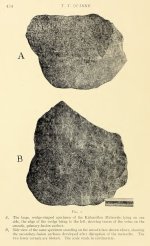bobfoundit
Greenie
Mr. Leo Kern , Section 18 , Township 136, Range 92 , saw the
fall. He was walking home about 10 o'clock at night, when
suddenly there was a bright light. At first it was like a bright
shooting star ; then it became a streak of fire until it burst like a
Roman candle. It appeared to be coming from the southeast,
falling at an angle of about 15° to the horizontal. It made a
“ rattling sound like an airship ,” and when it burst the earth
all about him trembled, and the house shook with the violence of
the explosion. He prudently took shelter behind a telegraph pole,
as the meteorite appeared to be coming directly toward him .
After the explosion he heard pieces flying through the air like
whistling bullets, and pieces rattled against the roof of his barn,
where he found some later.
After the meteorite had burst there
appeared to be a trail of " smoke or steam ” in the line of flight.
Several specimens were found by his daughters, Misses Emma and
Irene Kern, and contributed by them to the collection of the
University of Minnesota.
Mrs. Nell F. Rodenbour, postmistress at Lemmon, South
Dakota, writing February 25 , 1919, describes the fall as follows:
I saw this meteorite myself and can only describe it thus: At about 11
o'clock at night we heard a dull roar like thunder, and we all ran out of the
house to see, and there appeared a bright flash of light across the whole sky.
It fell to the northwest , more north , and left a tail of light which remained
for fully fifteen minutes.
Lemmon is about 45 miles south and 8 miles east of the place
where most of the meteorite fell .
Mr. N. R. St. Marie, of Hettinger, North Dakota, wrote on
February 27 as follows:
The writer was lucky enough to get an almost perfect view of the meteo
rite. I was seated in an auto sky -gazing, when it attracted my attention
as a shooting star. In a moment I saw that it was out of ordinary. Starting
from very high it fell rapidly earthward, a little to the east of north, about
10 or 15 degrees, I judged. As it came down it illuminated the landscape
to almost the brilliancy of sunlight, but the light was first of a green and later
of a yellow hue. A faint whistling was discernable to part of our party ;
others, however, said they didn't notice any sound.
fall. He was walking home about 10 o'clock at night, when
suddenly there was a bright light. At first it was like a bright
shooting star ; then it became a streak of fire until it burst like a
Roman candle. It appeared to be coming from the southeast,
falling at an angle of about 15° to the horizontal. It made a
“ rattling sound like an airship ,” and when it burst the earth
all about him trembled, and the house shook with the violence of
the explosion. He prudently took shelter behind a telegraph pole,
as the meteorite appeared to be coming directly toward him .
After the explosion he heard pieces flying through the air like
whistling bullets, and pieces rattled against the roof of his barn,
where he found some later.
After the meteorite had burst there
appeared to be a trail of " smoke or steam ” in the line of flight.
Several specimens were found by his daughters, Misses Emma and
Irene Kern, and contributed by them to the collection of the
University of Minnesota.
Mrs. Nell F. Rodenbour, postmistress at Lemmon, South
Dakota, writing February 25 , 1919, describes the fall as follows:
I saw this meteorite myself and can only describe it thus: At about 11
o'clock at night we heard a dull roar like thunder, and we all ran out of the
house to see, and there appeared a bright flash of light across the whole sky.
It fell to the northwest , more north , and left a tail of light which remained
for fully fifteen minutes.
Lemmon is about 45 miles south and 8 miles east of the place
where most of the meteorite fell .
Mr. N. R. St. Marie, of Hettinger, North Dakota, wrote on
February 27 as follows:
The writer was lucky enough to get an almost perfect view of the meteo
rite. I was seated in an auto sky -gazing, when it attracted my attention
as a shooting star. In a moment I saw that it was out of ordinary. Starting
from very high it fell rapidly earthward, a little to the east of north, about
10 or 15 degrees, I judged. As it came down it illuminated the landscape
to almost the brilliancy of sunlight, but the light was first of a green and later
of a yellow hue. A faint whistling was discernable to part of our party ;
others, however, said they didn't notice any sound.



